Vibration Control and Modeling of Building Structures: A Report
VerifiedAdded on 2021/04/24
|7
|1189
|48
Report
AI Summary
This report provides an overview of vibration control and modeling in building structures, focusing on the challenges posed by seismic activities. The report, with Australia as the chosen country for analysis, discusses the importance of measuring safety parameters to protect structures and human resources. It highlights the need for passive or active control, strategy implementation, and mathematical modeling. The research methodology includes a literature review, descriptive research design, and data collection from secondary sources such as online journals and government websites. The analysis employs qualitative methods to assess data related to building types and their associated parameters. The report aims to model structures, estimate sensing parameters, and mitigate vibration-related problems, contributing to the understanding of structural safety in the face of natural hazards.
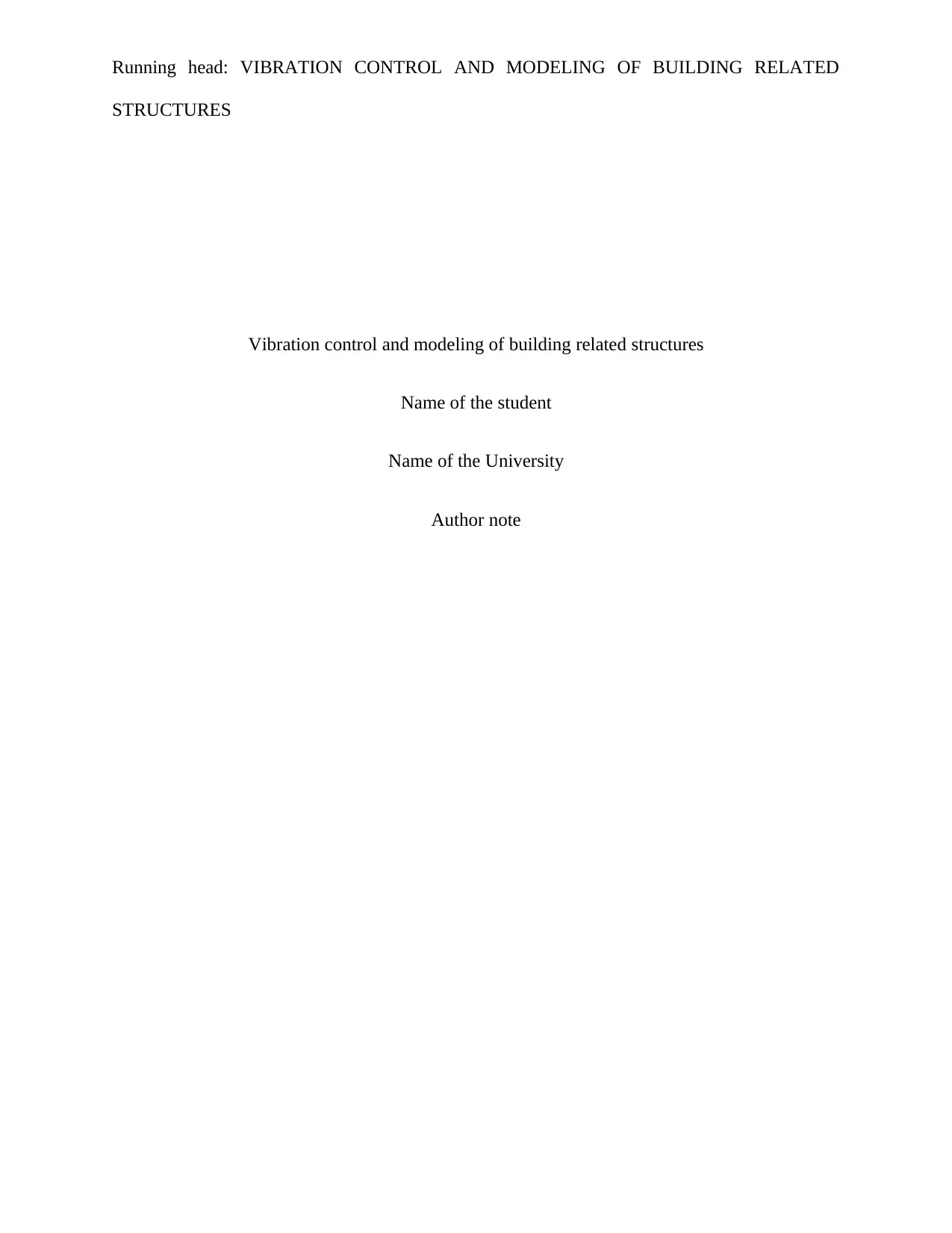
Running head: VIBRATION CONTROL AND MODELING OF BUILDING RELATED
STRUCTURES
Vibration control and modeling of building related structures
Name of the student
Name of the University
Author note
STRUCTURES
Vibration control and modeling of building related structures
Name of the student
Name of the University
Author note
Paraphrase This Document
Need a fresh take? Get an instant paraphrase of this document with our AI Paraphraser
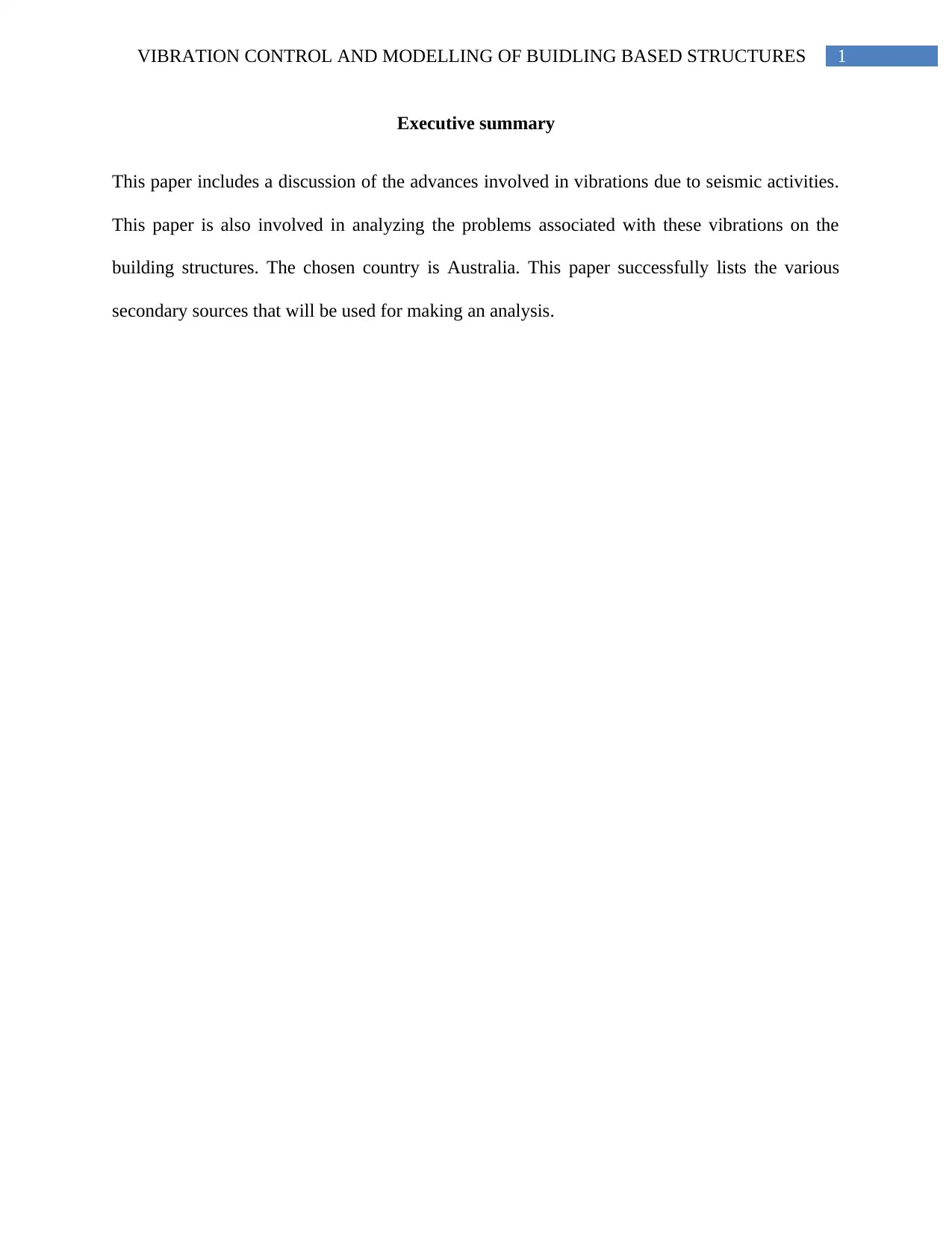
1VIBRATION CONTROL AND MODELLING OF BUIDLING BASED STRUCTURES
Executive summary
This paper includes a discussion of the advances involved in vibrations due to seismic activities.
This paper is also involved in analyzing the problems associated with these vibrations on the
building structures. The chosen country is Australia. This paper successfully lists the various
secondary sources that will be used for making an analysis.
Executive summary
This paper includes a discussion of the advances involved in vibrations due to seismic activities.
This paper is also involved in analyzing the problems associated with these vibrations on the
building structures. The chosen country is Australia. This paper successfully lists the various
secondary sources that will be used for making an analysis.
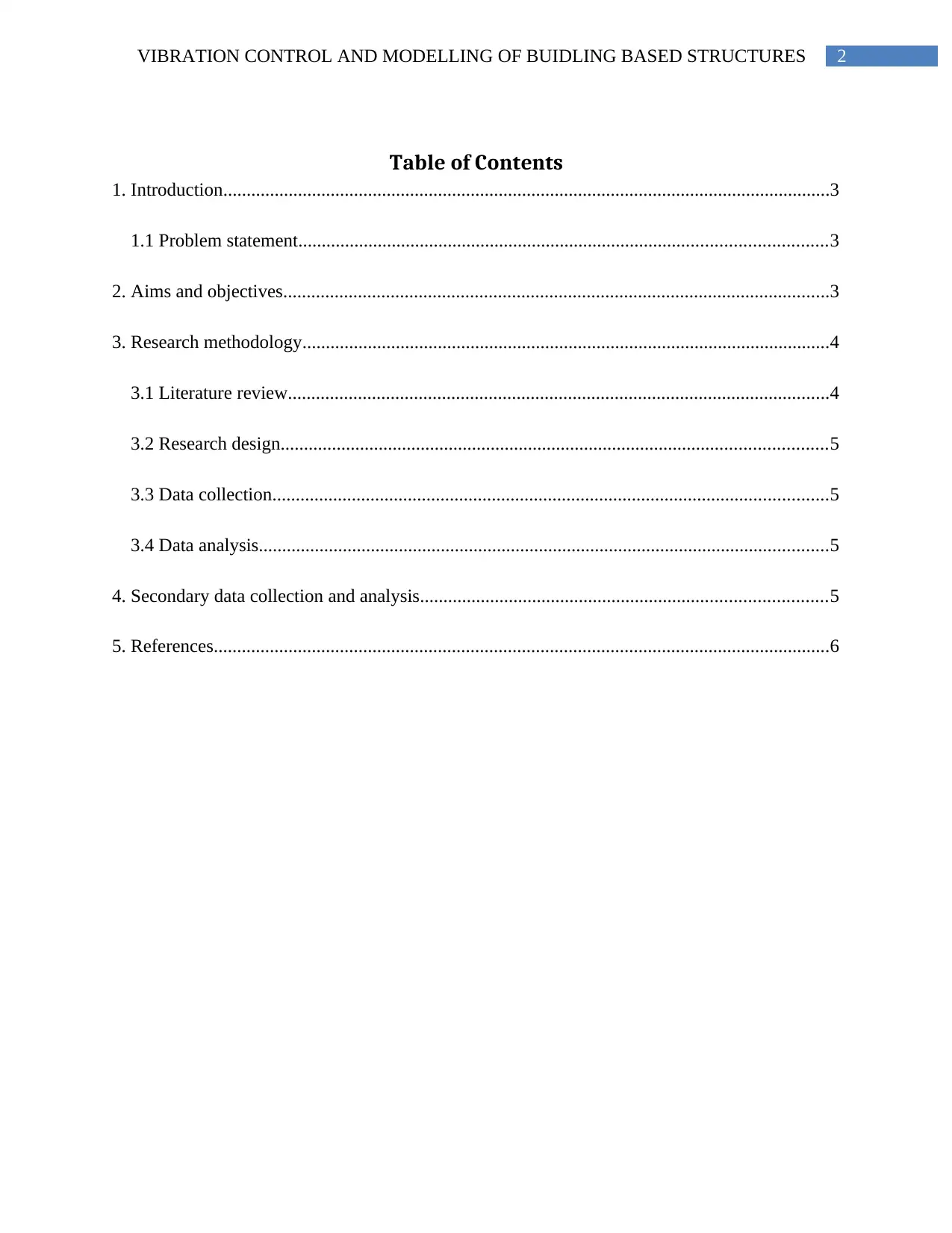
2VIBRATION CONTROL AND MODELLING OF BUIDLING BASED STRUCTURES
Table of Contents
1. Introduction..................................................................................................................................3
1.1 Problem statement.................................................................................................................3
2. Aims and objectives.....................................................................................................................3
3. Research methodology.................................................................................................................4
3.1 Literature review....................................................................................................................4
3.2 Research design.....................................................................................................................5
3.3 Data collection.......................................................................................................................5
3.4 Data analysis..........................................................................................................................5
4. Secondary data collection and analysis.......................................................................................5
5. References....................................................................................................................................6
Table of Contents
1. Introduction..................................................................................................................................3
1.1 Problem statement.................................................................................................................3
2. Aims and objectives.....................................................................................................................3
3. Research methodology.................................................................................................................4
3.1 Literature review....................................................................................................................4
3.2 Research design.....................................................................................................................5
3.3 Data collection.......................................................................................................................5
3.4 Data analysis..........................................................................................................................5
4. Secondary data collection and analysis.......................................................................................5
5. References....................................................................................................................................6
⊘ This is a preview!⊘
Do you want full access?
Subscribe today to unlock all pages.

Trusted by 1+ million students worldwide
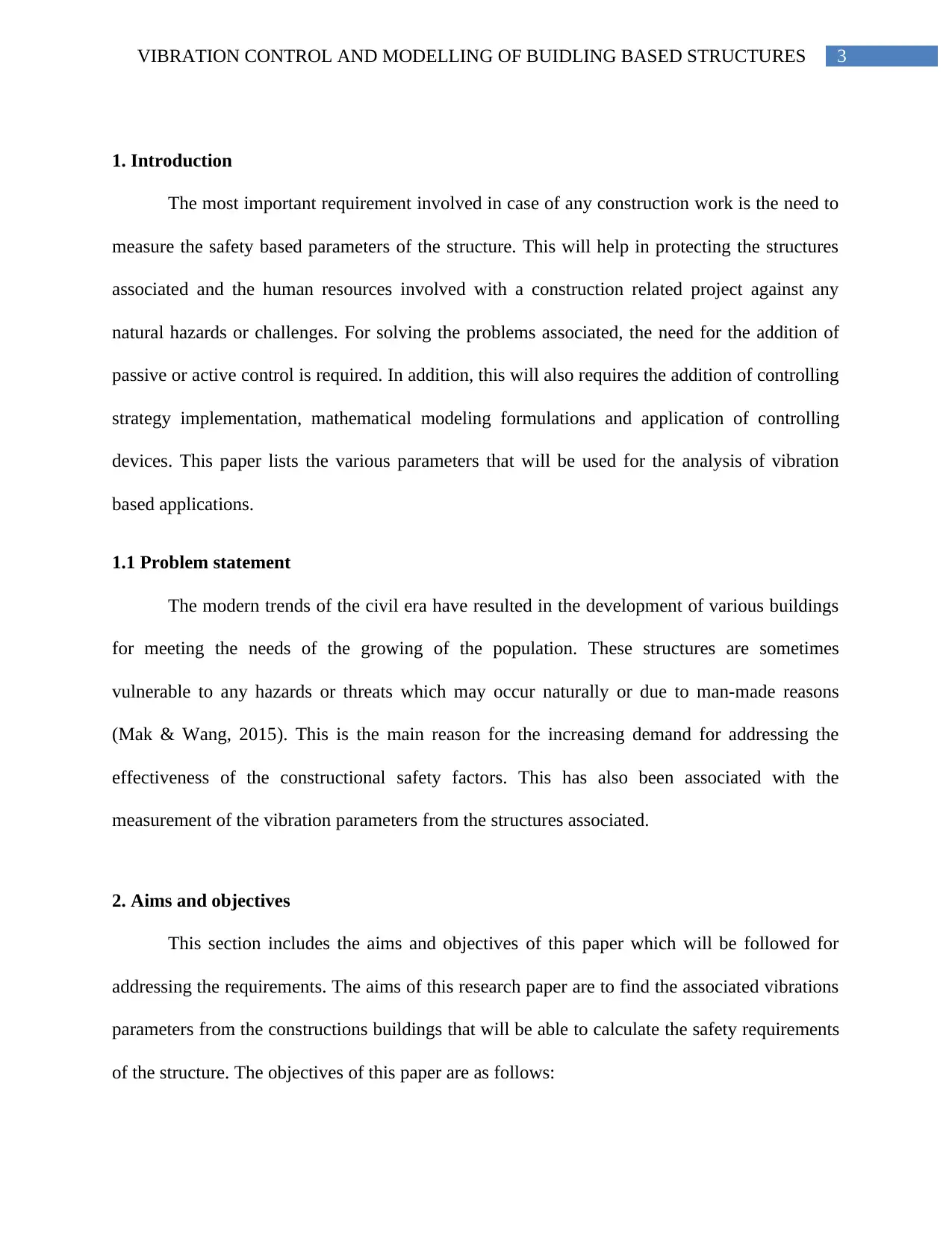
3VIBRATION CONTROL AND MODELLING OF BUIDLING BASED STRUCTURES
1. Introduction
The most important requirement involved in case of any construction work is the need to
measure the safety based parameters of the structure. This will help in protecting the structures
associated and the human resources involved with a construction related project against any
natural hazards or challenges. For solving the problems associated, the need for the addition of
passive or active control is required. In addition, this will also requires the addition of controlling
strategy implementation, mathematical modeling formulations and application of controlling
devices. This paper lists the various parameters that will be used for the analysis of vibration
based applications.
1.1 Problem statement
The modern trends of the civil era have resulted in the development of various buildings
for meeting the needs of the growing of the population. These structures are sometimes
vulnerable to any hazards or threats which may occur naturally or due to man-made reasons
(Mak & Wang, 2015). This is the main reason for the increasing demand for addressing the
effectiveness of the constructional safety factors. This has also been associated with the
measurement of the vibration parameters from the structures associated.
2. Aims and objectives
This section includes the aims and objectives of this paper which will be followed for
addressing the requirements. The aims of this research paper are to find the associated vibrations
parameters from the constructions buildings that will be able to calculate the safety requirements
of the structure. The objectives of this paper are as follows:
1. Introduction
The most important requirement involved in case of any construction work is the need to
measure the safety based parameters of the structure. This will help in protecting the structures
associated and the human resources involved with a construction related project against any
natural hazards or challenges. For solving the problems associated, the need for the addition of
passive or active control is required. In addition, this will also requires the addition of controlling
strategy implementation, mathematical modeling formulations and application of controlling
devices. This paper lists the various parameters that will be used for the analysis of vibration
based applications.
1.1 Problem statement
The modern trends of the civil era have resulted in the development of various buildings
for meeting the needs of the growing of the population. These structures are sometimes
vulnerable to any hazards or threats which may occur naturally or due to man-made reasons
(Mak & Wang, 2015). This is the main reason for the increasing demand for addressing the
effectiveness of the constructional safety factors. This has also been associated with the
measurement of the vibration parameters from the structures associated.
2. Aims and objectives
This section includes the aims and objectives of this paper which will be followed for
addressing the requirements. The aims of this research paper are to find the associated vibrations
parameters from the constructions buildings that will be able to calculate the safety requirements
of the structure. The objectives of this paper are as follows:
Paraphrase This Document
Need a fresh take? Get an instant paraphrase of this document with our AI Paraphraser
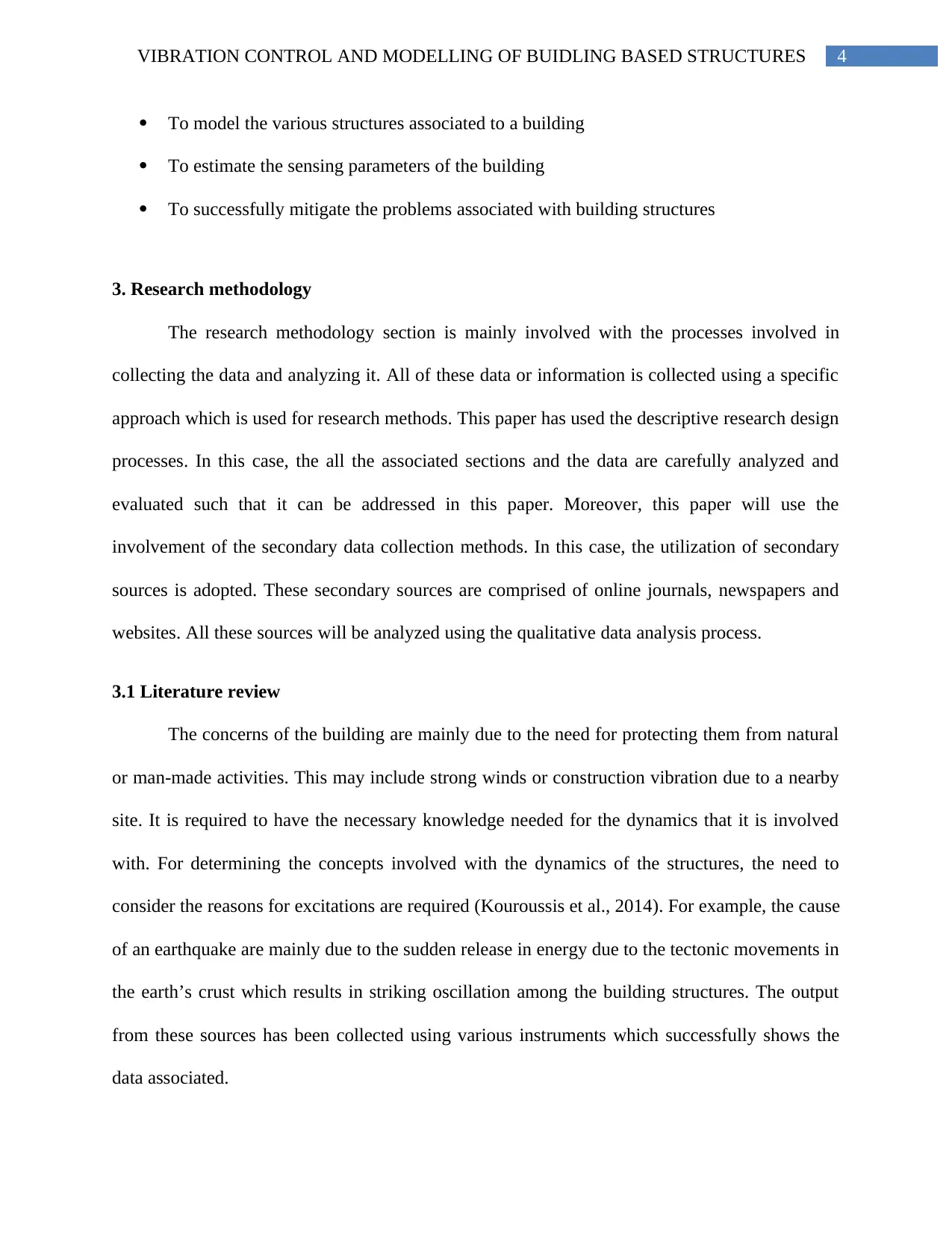
4VIBRATION CONTROL AND MODELLING OF BUIDLING BASED STRUCTURES
To model the various structures associated to a building
To estimate the sensing parameters of the building
To successfully mitigate the problems associated with building structures
3. Research methodology
The research methodology section is mainly involved with the processes involved in
collecting the data and analyzing it. All of these data or information is collected using a specific
approach which is used for research methods. This paper has used the descriptive research design
processes. In this case, the all the associated sections and the data are carefully analyzed and
evaluated such that it can be addressed in this paper. Moreover, this paper will use the
involvement of the secondary data collection methods. In this case, the utilization of secondary
sources is adopted. These secondary sources are comprised of online journals, newspapers and
websites. All these sources will be analyzed using the qualitative data analysis process.
3.1 Literature review
The concerns of the building are mainly due to the need for protecting them from natural
or man-made activities. This may include strong winds or construction vibration due to a nearby
site. It is required to have the necessary knowledge needed for the dynamics that it is involved
with. For determining the concepts involved with the dynamics of the structures, the need to
consider the reasons for excitations are required (Kouroussis et al., 2014). For example, the cause
of an earthquake are mainly due to the sudden release in energy due to the tectonic movements in
the earth’s crust which results in striking oscillation among the building structures. The output
from these sources has been collected using various instruments which successfully shows the
data associated.
To model the various structures associated to a building
To estimate the sensing parameters of the building
To successfully mitigate the problems associated with building structures
3. Research methodology
The research methodology section is mainly involved with the processes involved in
collecting the data and analyzing it. All of these data or information is collected using a specific
approach which is used for research methods. This paper has used the descriptive research design
processes. In this case, the all the associated sections and the data are carefully analyzed and
evaluated such that it can be addressed in this paper. Moreover, this paper will use the
involvement of the secondary data collection methods. In this case, the utilization of secondary
sources is adopted. These secondary sources are comprised of online journals, newspapers and
websites. All these sources will be analyzed using the qualitative data analysis process.
3.1 Literature review
The concerns of the building are mainly due to the need for protecting them from natural
or man-made activities. This may include strong winds or construction vibration due to a nearby
site. It is required to have the necessary knowledge needed for the dynamics that it is involved
with. For determining the concepts involved with the dynamics of the structures, the need to
consider the reasons for excitations are required (Kouroussis et al., 2014). For example, the cause
of an earthquake are mainly due to the sudden release in energy due to the tectonic movements in
the earth’s crust which results in striking oscillation among the building structures. The output
from these sources has been collected using various instruments which successfully shows the
data associated.
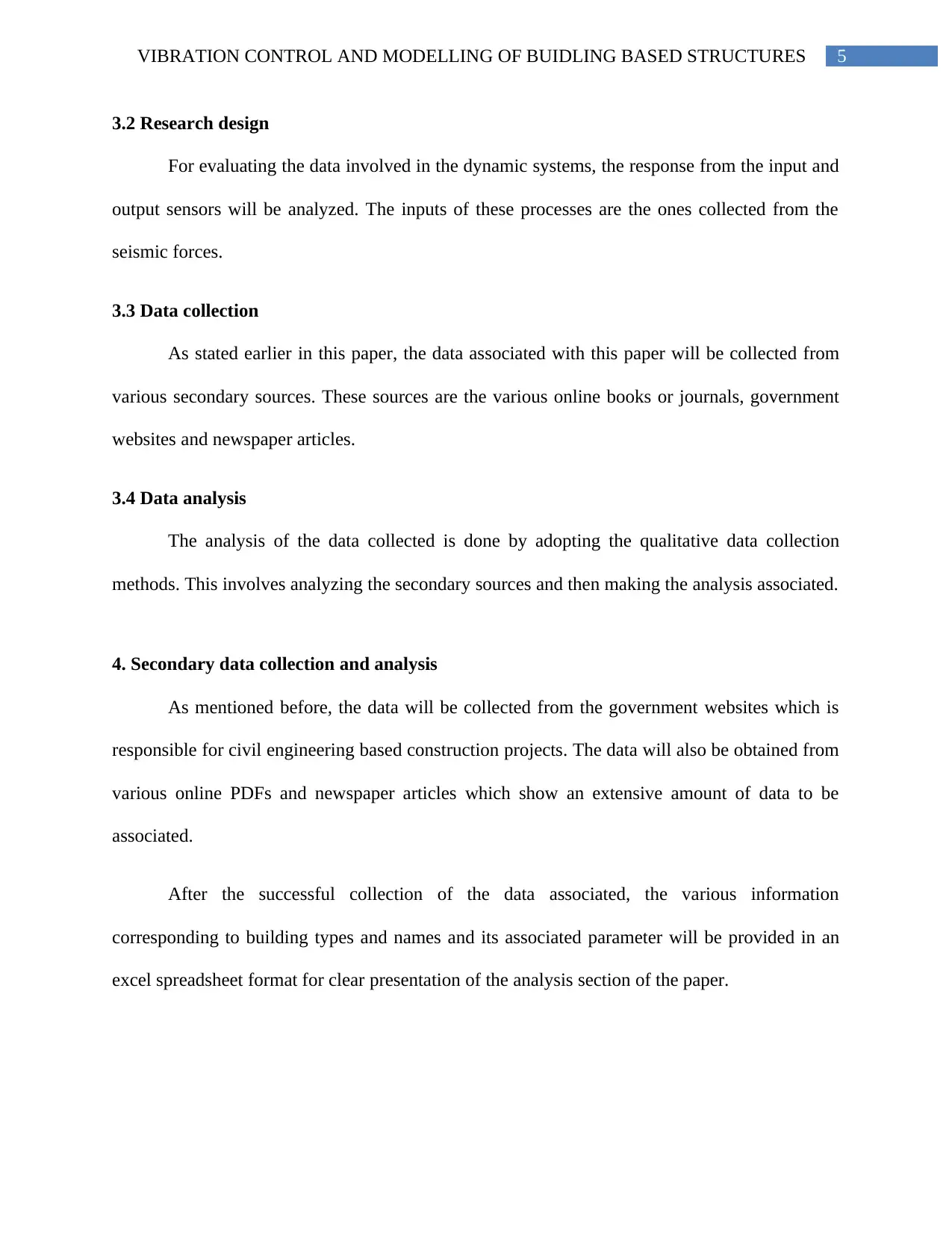
5VIBRATION CONTROL AND MODELLING OF BUIDLING BASED STRUCTURES
3.2 Research design
For evaluating the data involved in the dynamic systems, the response from the input and
output sensors will be analyzed. The inputs of these processes are the ones collected from the
seismic forces.
3.3 Data collection
As stated earlier in this paper, the data associated with this paper will be collected from
various secondary sources. These sources are the various online books or journals, government
websites and newspaper articles.
3.4 Data analysis
The analysis of the data collected is done by adopting the qualitative data collection
methods. This involves analyzing the secondary sources and then making the analysis associated.
4. Secondary data collection and analysis
As mentioned before, the data will be collected from the government websites which is
responsible for civil engineering based construction projects. The data will also be obtained from
various online PDFs and newspaper articles which show an extensive amount of data to be
associated.
After the successful collection of the data associated, the various information
corresponding to building types and names and its associated parameter will be provided in an
excel spreadsheet format for clear presentation of the analysis section of the paper.
3.2 Research design
For evaluating the data involved in the dynamic systems, the response from the input and
output sensors will be analyzed. The inputs of these processes are the ones collected from the
seismic forces.
3.3 Data collection
As stated earlier in this paper, the data associated with this paper will be collected from
various secondary sources. These sources are the various online books or journals, government
websites and newspaper articles.
3.4 Data analysis
The analysis of the data collected is done by adopting the qualitative data collection
methods. This involves analyzing the secondary sources and then making the analysis associated.
4. Secondary data collection and analysis
As mentioned before, the data will be collected from the government websites which is
responsible for civil engineering based construction projects. The data will also be obtained from
various online PDFs and newspaper articles which show an extensive amount of data to be
associated.
After the successful collection of the data associated, the various information
corresponding to building types and names and its associated parameter will be provided in an
excel spreadsheet format for clear presentation of the analysis section of the paper.
⊘ This is a preview!⊘
Do you want full access?
Subscribe today to unlock all pages.

Trusted by 1+ million students worldwide
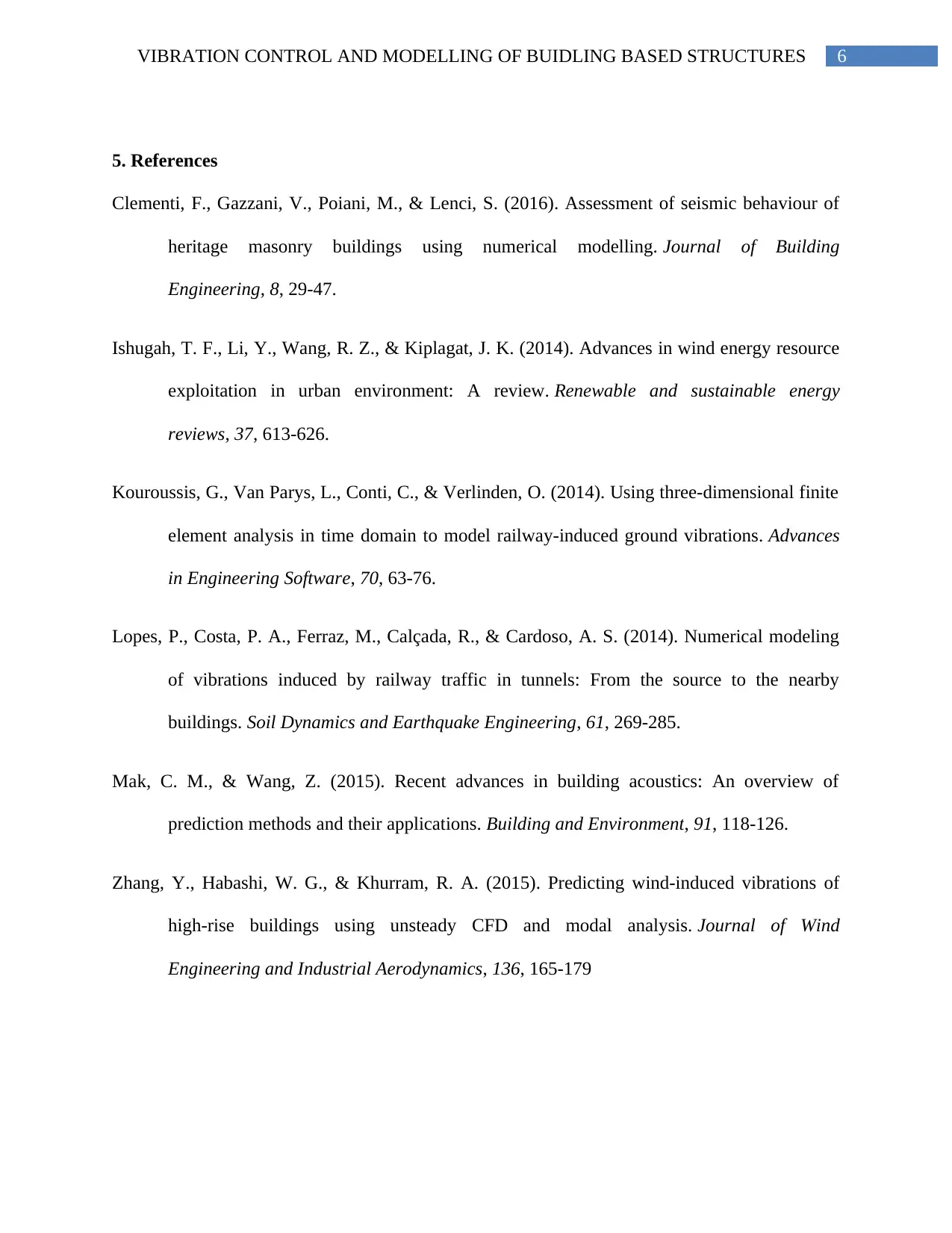
6VIBRATION CONTROL AND MODELLING OF BUIDLING BASED STRUCTURES
5. References
Clementi, F., Gazzani, V., Poiani, M., & Lenci, S. (2016). Assessment of seismic behaviour of
heritage masonry buildings using numerical modelling. Journal of Building
Engineering, 8, 29-47.
Ishugah, T. F., Li, Y., Wang, R. Z., & Kiplagat, J. K. (2014). Advances in wind energy resource
exploitation in urban environment: A review. Renewable and sustainable energy
reviews, 37, 613-626.
Kouroussis, G., Van Parys, L., Conti, C., & Verlinden, O. (2014). Using three-dimensional finite
element analysis in time domain to model railway-induced ground vibrations. Advances
in Engineering Software, 70, 63-76.
Lopes, P., Costa, P. A., Ferraz, M., Calçada, R., & Cardoso, A. S. (2014). Numerical modeling
of vibrations induced by railway traffic in tunnels: From the source to the nearby
buildings. Soil Dynamics and Earthquake Engineering, 61, 269-285.
Mak, C. M., & Wang, Z. (2015). Recent advances in building acoustics: An overview of
prediction methods and their applications. Building and Environment, 91, 118-126.
Zhang, Y., Habashi, W. G., & Khurram, R. A. (2015). Predicting wind-induced vibrations of
high-rise buildings using unsteady CFD and modal analysis. Journal of Wind
Engineering and Industrial Aerodynamics, 136, 165-179
5. References
Clementi, F., Gazzani, V., Poiani, M., & Lenci, S. (2016). Assessment of seismic behaviour of
heritage masonry buildings using numerical modelling. Journal of Building
Engineering, 8, 29-47.
Ishugah, T. F., Li, Y., Wang, R. Z., & Kiplagat, J. K. (2014). Advances in wind energy resource
exploitation in urban environment: A review. Renewable and sustainable energy
reviews, 37, 613-626.
Kouroussis, G., Van Parys, L., Conti, C., & Verlinden, O. (2014). Using three-dimensional finite
element analysis in time domain to model railway-induced ground vibrations. Advances
in Engineering Software, 70, 63-76.
Lopes, P., Costa, P. A., Ferraz, M., Calçada, R., & Cardoso, A. S. (2014). Numerical modeling
of vibrations induced by railway traffic in tunnels: From the source to the nearby
buildings. Soil Dynamics and Earthquake Engineering, 61, 269-285.
Mak, C. M., & Wang, Z. (2015). Recent advances in building acoustics: An overview of
prediction methods and their applications. Building and Environment, 91, 118-126.
Zhang, Y., Habashi, W. G., & Khurram, R. A. (2015). Predicting wind-induced vibrations of
high-rise buildings using unsteady CFD and modal analysis. Journal of Wind
Engineering and Industrial Aerodynamics, 136, 165-179
1 out of 7
Related Documents
Your All-in-One AI-Powered Toolkit for Academic Success.
+13062052269
info@desklib.com
Available 24*7 on WhatsApp / Email
![[object Object]](/_next/static/media/star-bottom.7253800d.svg)
Unlock your academic potential
Copyright © 2020–2025 A2Z Services. All Rights Reserved. Developed and managed by ZUCOL.





